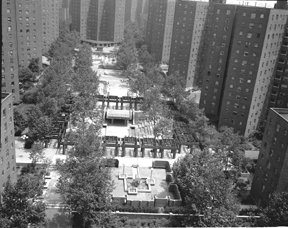Pink Playground
The Daily Plant : Thursday, December 2, 2004
HAPPY BIRTHDAY, MR. PINK

Chances are, if you can think of anyone named Mr. Pink, it would be Steve Buscemi’s character from Quentin Tarantino’s 1992 film Reservoir Dogs. That’s not who I’m talking about; but now that I’ve got your ear, let me tell you about Louis H. Pink, the man who brought the innovation of public housing to the United States.
Born in Wasau, Wisconsin, on December 4, 1882, Pink attended St. Lawrence University in Canton, New York, and later received his law degree from New York Law School in 1906. After being admitted to the Bar, he lived and worked in New York City. As part of his extensive record of civil service, he served as the State Insurance superintendent, the chairman of the New York State Housing Board, and wrote several books, including The New Day in Housing (1928), the first volume on modern community housing to be published in the United States. In his book, he offered a variety of solutions to the nation’s housing crisis, including more slum condemnation, tax exemptions for speculative house builders, and the exploration of "cooperative housing plans." A 1928 New York Times review called The New Day in Housing, "an exceedingly interesting, forward-looking, and on the whole, hopeful book."
During his tenure as the Chairman of the State Board of Housing (1937 to 1939), Pink suggested that Mayor LaGuardia enact a massive rental housing program. He felt affordable housing should be constructed not only for the middle income earners, but also for the lower paid wage earners. Taking their inspiration from innovative public housing projects produced in Europe, Pink and his fellow reformers called for measures stronger than changing building codes and constructing "model tenements." In 1934, the New York City Housing Authority was created, the first such local authority of its kind in the United States. The agency’s first project, completed in 1936, was a 210-unit development on the Lower East Side, named appropriately, The First Houses. Shortly after they were built the United States Housing Act was passed, setting aside $100 million for housing construction.
The First Houses and subsequent developments were based on designs that originated in the 19th century: low-rise apartment buildings with playgrounds, shops, and places to hold community meetings. Each apartment had a full bathroom and kitchen with windows providing outdoor light and access to air on both sides, making the new dwellings extremely desirable. Although the design of public housing complexes changed extensively over the years, the inclusion of recreational space remained prominent throughout. By the 1950s, Robert Moses added the construction of public housing to his growing list of jobs. And the playgrounds attached to housing projects built during his reign bear the peculiar mark of the Moses mind. They are precisely one acre, no more, no less.
One such perfect playground lies adjacent to the Louis H. Pink Houses in East New York. During the first half of the twentieth century, East New York had witnessed a steady inflow of German, Italian, Russian, and Polish immigrants, which led to a housing shortage in the late 1940s. Adding to the problem in the post-war era was the need to relocate families displaced from sites of other public improvements around the city. In response, planning began in 1955 for a new federally aided, low-rent public housing project. The City acquired the housing site on March 13, 1957. The Board of Estimate approved the revised plan to develop 22 eight-story buildings on April 25, 1957, with the goal of housing 1,500 families. Finally, the City decided to name the complex and the planned adjoining recreation area in honor of the man who brought the concept to New York nearly 30 years prior and who passed away on May 18, 1955.
Written by John Mattera
Parks & Recreation Librarian
QUOTATION FOR THE DAY
"To love is to suffer. To avoid suffering, one must not love. But then, one suffers from not loving. Therefore, to love is to suffer; not to love is to suffer; to suffer is to suffer. To be happy is to love. To be happy, then, is to suffer, but suffering makes one unhappy. Therefore, to be happy, one must love or love to suffer or suffer from too much happiness."
Woody Allen
(b. 1935)
Check out your park's Vital Signs
Clean & Safe
Green & Resilient
Empowered & Engaged Users
Share your feedback or learn more about how this park is part of a
Vital Park System


